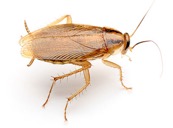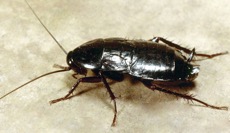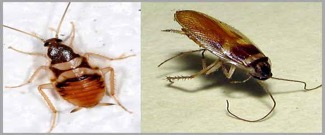Cockroach Control
Cockroaches are found all over the world. There are more than 3,500 species of cockroach. The most common varieties in Australia include the German, American and Oriental cockroaches.
American cockroaches are large and black. German cockroaches are smaller and brown. Oriental cockroaches are medium sized and dark brown to black in colour.
Because cockroaches eat a wide range of food, including rotting garbage, they spread a number of diseases to humans including salmonella and gastroenteritis. Recent studies have indicated cockroaches can also cause allergies.

American Cockroach
(Periplaneta americana)
The American cockroach is the largest cockroach found in houses.
Females can hatch up to 150 offspring per year. Cockroaches don’t get their wings until they become adults.
American cockroaches are also known as “water bugs” because they are so commonly found near rich water resources, like puddles and water pipes.
American cockroaches are nocturnal. They rest by day and forage for food at night.
Characteristics of American Cockroach:
Size: 2"
Colour: Reddish brown, with a yellowish figure eight pattern on the back of their head
Diet
American cockroaches will eat just about anything, including plants and other insects.
Life cycle
Females produce an egg case called an ootheca which protrudes from the tip of the abdomen.
After about two days, the egg cases are placed on a surface in a safe location.
Egg cases are about 0.9 centimetres (0.35 in) long, brown, and purse shaped. Immature cockroaches emerge from egg cases in 6 to 8 weeks and require 6 to 12 months to mature.
Adult cockroaches can live up to one year, during which females produce an average of 150 young

Australian Cockroach
(Periplaneta australasiae)
Despite their name, they are not native to Australia. They originated from Asia.
They became totally adapted to the domestic life. They are pest in households.
This species of cockroach, and the German cockroach, have given the Cockroach group the bad name.
They transmitted diseases when they occur in house and restaurants.
They can contaminate food and must be controlled.
Characteristics of Australian Cockroach:
Size: 30-35mm
Colour: Yellow border on pronotum (area behind the head) is very distinct. Dark Reddish brown in colour.
Diet
Omnivorous. Scavenger. Prefers decaying organic vegetable matter. Will feed on starch materials such as book bindings..
Life cycle
Gradual / Incomplete metamorphosis (egg – nymph – adult). Eggs are encased in an egg capsule (Ootheca). Female drops the egg capsule (Ootheca) shortly after it is formed near a food source, in crevices, on walls, or under workable material such as moist wood, so as to camouflage it.
Eggs per capsule: 16-24.
Incubation period: 30-40 days.
Nymphal period: 6-12 months.
Nymphs normally moult 10-12 times to reach adulthood. Females may produce 12-30 egg capsules in a lifetime. Egg capsules are completed and dropped at about 10 day intervals. Adult lifespan: up to 8 months.
Habitat
Found mostly outdoors. Often found under bark of trees, woodpiles and locations with moist and decaying vegetable matter.
Can be found inside homes in cupboards, behind drawers, in all food areas and industrial areas, subfloor areas, wall and roof voids.
Favours warm, humid environments. Is not found as readily in cooler climates compared to the American cockroach.
Damage
Orchid virus transmission by the Australian cockroach. It invades a structure it will feed upon varieties of starchy materials.

German cockroach
(Blatella germanica)
The German cockroach is a small species of cockroach.
The male has wings that cover the abdomen, while the female has wings that do not cover the abdomen completely. The male appears more slender than the female, the female appears wider..
They need less moisture than the German cockroach so they tend to be more broadly distributed in the home, such as in living rooms and bedrooms.
Characteristics of German cockroach:
Size: 1/2" to 5/8"
Colour: Brown to Dark Brown
Diet
German Cockroaches are attracted to sweet and floury foods. They also eat non-organic items such as toothpaste and books.
Life cycle
A female brown-banded cockroach carries her egg capsule for a day or two, and then attaches it to a protected surface.
The egg case is purse-shaped, light brown in colour and is cemented in place, usually to the side or under surfaces of infested objects.
Females will produce about 14 egg capsules during their adult life, each containing about 18 eggs. These hatch in 50-75 days, depending on temperature. Under room conditions, nymphs mature in about 160 days. Adults may live up to 10 months.
This species reproduces more rapidly than the other common pest cockroaches. A single female and her offspring can produce over 100,000 individuals in a year when conditions are ideal.
Damage
German cockroaches can multiply very quickly and become a nuisance in large numbers. Cockroaches are unsightly, intrude on our homes and lives, contaminate food, and are capable of transmitting diseases.

Oriental Cockroach
(Blatta orientalis)
Appearance
- Dark brown or black in colour.
- 20 -25mm long.
- The wings undeveloped in female and cover ¾ length of the abdomen in the male.
Lifecycle
- Females deposit 16 eggs in an ootheca (egg case).
- Hatch in 2 months.
- Nymphs take 6-18 months to develop into adults.
Habits
- Highly adapted for surviving in the natural environment, Oriental cockroaches thrive in cool, damp areas such as basements, drains and openings beneath porches.
- Known for their preference for feeding on garbage and decay, these insects can most commonly be found in rubbish tips and leaf litters.
- Runs rather than flies.

Brown Banded Cockroach
(Supella longipalpa)
Brown-banded Cockroach control and Facts
The Brown-banded cockroach is a small species of cockroach.
The male has wings that cover the abdomen, while the female has wings that do not cover the abdomen completely. The male appears more slender than the female, the female appears wider.
They need less moisture than the German cockroach so they tend to be more broadly distributed in the home, such as in living rooms and bedrooms.
Characteristics of Brown banded Cockroach:
Size: 10 to 14mm
Colour: light brown in colour; with two light, irregular bands along their wings.
Diet
The Brown banded Cockroach will eat almost anything. Brown banded cockroaches prefer to eat starchy foods, such as wallpaper paste and book bindings. Sometimes they’ll eat non-organic things, like nylon stockings.
Life cycle
A female brown-banded cockroach carries her egg capsule for a day or two, and then attaches it to a protected surface.
The egg case is purse-shaped, light brown in colour and is cemented in place, usually to the side or under surfaces of infested objects.
Females will produce about 14 egg capsules during their adult life, each containing about 18 eggs. These hatch in 50-75 days, depending on temperature. Under room conditions, nymphs mature in about 160 days. Adults may live up to 10 months.
Habitat
Brown banded cockroaches prefer warmer, drier, and higher locations than most cockroaches. While most cockroaches prefer to live in kitchens and pantries, Brown banded cockroaches will live in any room in the house. They do not need much moisture and avoid light whenever the can.
Damage
Brown cockroaches have the ability to multiply quickly and can be a nuisance in large numbers. Roaches intrude on homes, contaminate food, and sometimes transmit diseases..

